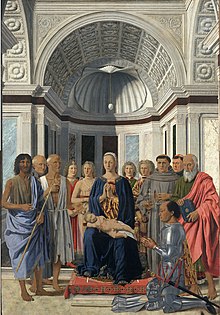Ovoid (design element)
Egg-shaped three-dimensional bodies are referred to as ovoid . Also rounded rectangles or trapezoids, which appear in two-dimensional depictions of animals or depictions of humanoid forms of the peoples of the northwest coast of North America , e.g. B. the Kwakiutl , Haida and Tlingit play a major role are so called. This use of the term related to the art of the Northwest Coast peoples was coined by Bill Holm .
Ovoid in the art of the peoples of the American Northwest Coast
Ovoids are often drawn with a thick line ( formline ) and convex at the top, and often thinner and straight or concave at the bottom. They can be filled with faces, facial elements such as eyes or with other ovids. Carcasses are often decomposed into a nonlinear collection of ovids with a compact outer outline (see illustration).
Conversely, ovoids are assembled into complex patterns that create a simultaneous perspective on different aspects of a living being or a mythical figure. Negative recesses in ovaries often result in new shapes. In the art of weaving these patterns are z. T. generated with the help of templates.

Ovoid and the other typical elements of Northwest Coast culture such as shape lines, filled or split U-shaped surfaces or thick S- and T-shaped elements are also known as the Northwest Coast alphabet . The artistic variation of ovoid representations has been preserved in the painting of the north-west coast peoples to this day and is one of their "trademarks".
Other uses of the ovoid in art

.
The importance of the ovoid on an altarpiece by Piero della Francesca has been much discussed . It is probably an ostrich egg . The custom of hanging ostrich eggs in sacred buildings has been traceable in the Coptic Church since the 13th century and also among Armenian, Greek Orthodox, Latin and Nestorian Christians as well as in Islam. In ancient Egypt, the ostrich egg served as a symbol of the unity of the world. The symbolic meaning in the Middle Ages probably related to the behavior of the ostrich towards its eggs, which was understood as a symbol for the relationship between humans and God. The ostrich egg was also used for egg oracles . Later it symbolized birth, life and resurrection and found its way into Easter customs.
The Romanian sculptor Constantin Brâncuși (1876–1957), like other expressionist artists, often worked with basic ovoid forms.
The sculpture Composition from the Ovoid by Georges Vantongerloo (1918) consists of rectangular wooden blocks and is not in the shape of an ovoid.
literature
- Bill Holm: Northwest Coast Indian Art: An Analysis of Forms. Seattle. University of Washington Press 1965. ISBN 978-0295951027
- Audrey Hawthorn: Kwakiutl Art. University of Washington Press 1979.
- Daina Augaitis, Marianne Jones, Peter L. Macnair: Raven Traveling: Two Centuries of Haida Art. Greystone Books Canada / Seattle: University of Washington Press 2008.


